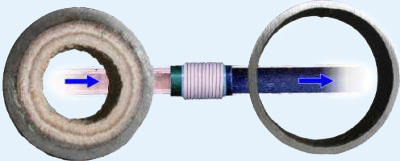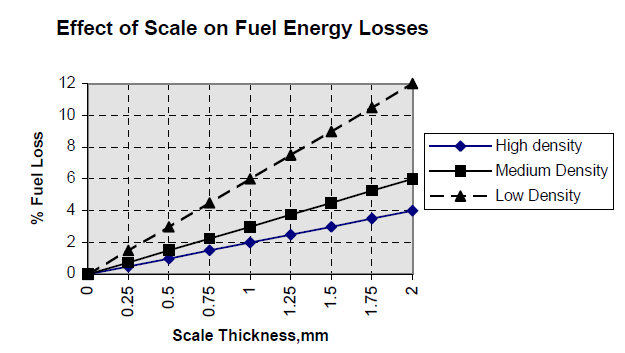The AntiCa++ devices are designed for scale elimination in existing or newly installed liquid systems where hard scale is formed. When the supplied liquid is heated, the temperature – pressure changes relives a certain amount of CaCO3 (carbon calcite) ions from the liquid bond.
Where the AntiCa++ devices are not installed, the freed carbon calcite ions adhere to the system surfaces in form of hard scale. The continuous heating of supplied liquid promotes continuous system scale buildup. In time, the cumulated scale reduces the system thermal efficiency and increase the system flow resistance. The increased liquid flow resistance increases the system pumping power. To compensate for the heater loss efficiency the heater settings are adjusted, resulting in increased fuel consumption, increases carbon production and increased associated carbon tax.
Where an AntiCa++ device is installed on scaled system it promotes changes of hard scale forming carbon calcite in the supplied liquid to soft aragonite carbon calcite that does not form scaling on the system surfaces but floats in the treated liquid in form of “mud”. In closed liquid systems the formed aragonite carbon calcite must be removed either by filtration or by mud traps. In time the cumulated scale on the system surfaces softens and is peeled off by the liquid flow. The exposed steel piping is coated with Fe3 O4 inhibiting further inner piping corrosion.
The demonstration of scale removal and prevention by electromagnetic field installed on the heated liquid system is shown below.

Depending on the water chemistry, different types of scale exist.
The scale problems reduce thermal efficiencies. One should therefore always inquire about descaling practice and feed water treatment.
Only “rules of thumb” figures for scale can be given as shown below. Losses are expressed in percent of fuel input as a function of the scale thickness. Inaccuracies are not caused by rough estimates of film heat transfer coefficients. Their value has no significant impact on the result. More critical is the thermal conductivity of scale layers that may vary widely.
High density ρ= 2,000-2,700, λ = 0.7-2.33
Medium density ρ = 1,000-2,500, λ= 0.15-1.16
Low density ρ = 300-1,200, λ= 0.08-0.23
Roh, ρ, is scale density in kg/m3,
Lambda, λ, is thermal conductivity in W/m°C.
Nevertheless even very thin layer (0.5 to 1 mm) of scale cause significant fuel losses. In addition scale built up cause thermal stress to the tubes and increases repair and maintenance costs.

Source : Dr. Kaupp Albrecht’s article : The sooth and scale problems
The most effective cost solution to reduce or eliminate scaling is to install AntiCa++ device.
Property of treated liquid
- Prevent scale formation
- Softens old scale
- Unchanged liquid composition
- Promote sedimentation
- Forms Fe3 O4 inside ferrous piping
- The change of treated liquid (architecture) structure is time sensitive
- The treated liquid is sensitive to external strong magnetic and electrical fields
Benefits of an AntiCa++ device installation:
- Installation without piping alteration
- Installation on metallic or plastic piping 1000 mm diameter maximum
- Low installation and operating cost
- Maintenance free operation
- Installation on new and old systems
- On existing installations in time it softens existing scale deposits
- Promotes formation of Fe3 O4 in steel piping
- Defers or eliminates frequency of liquid heaters replacement
- Maintain constant heater efficiency
- Maintains constant pumping operating cost
- Reduces equipment stress and possible heater failure associated with scale build up
- Maintain constant total system, life cycle carbon emission and associated carbon tax
- No increased of water consumption due to backwash
- No water pollution due to added chemicals
- No additional floor space for device installation
- Contributes to carbon reduction and high performance in green space
- Indoor/outdoor installation to -50° ambient temperature
- Installation on systems with surface temperatures to +170°C
- Resistant to most chemicals.
Some installation listings of AntiCa++ device:
- Drinking water, fermentation processes such as food, beer, pharmaceutical etc. where chemical water treatment and contamination of water are not desired.
- Sugar industry controlling hydroxide calcite Ca(OH)2 and sulfur solution.
- Pulp and paper preventing scale formation in Ca(HSO 3 ) 2 solution.
- Cooling systems of smelters.
- Cooling systems in power stations
- Liquid treatment of ash pipelines,.
- Water-cooled chiller systems included water side economizers.
- Hot water space heating.
- Domestic hot water systems.

